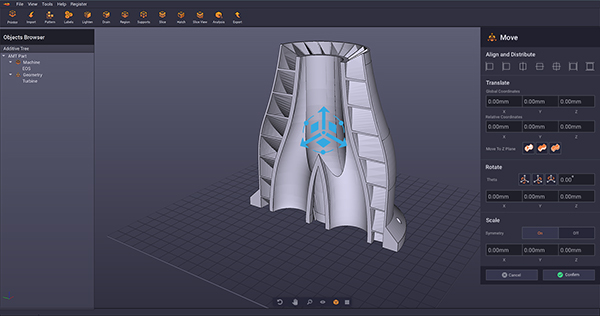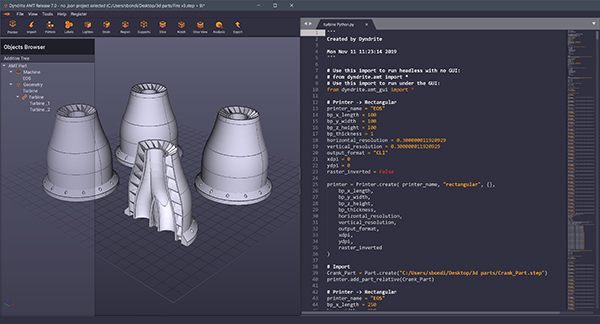
AM startup Dyndrite offers CAD-to-print solution with the promise to streamline the process. Image courtesy of Dyndrite.
Latest News
November 11, 2019
Harshil Goel, CEO of Dyndrite (Pronounced “Den-drite”), wants to do for AM (additive manufacturing) what Adobe has done for 2D printing. He wants to come up with the AM-version of PostScript, allowing people to print 3D objects with precision regardless of the authoring software or the printing hardware.
In the current CAD-to-print workflow, the mathamatically precise CAD model has to be converted to a triangulated format, STL being the widely adopted format at the present. Harshil thinks he can eliminate this step, thereby improving the efficiency and precision of the print job.
“With our technology, you can print directly from CAD data to toolpath,” said Harshil. The printing speed may not make a difference to those using AM for one-of-a-kind prototypes or a few unique units. However, “this will make a difference if you are, say, a medical device company that needs to print tens of thousands of uniform parts,” said Harshil.
 AM startup Dyndrite expects to streamline the CAD-to-print process with its print-prep software. Image courtesy of Dyndrite.
AM startup Dyndrite expects to streamline the CAD-to-print process with its print-prep software. Image courtesy of Dyndrite.New GPU-Accelerated Kernel for AM
Dyndrite has three offerings:
- The Dyndrite Accelerated Computation Engine (ACE), a GPU-powered, Python-accessible geometry kernel.
- The Dyndrite Additive Manufacturing Toolkit (AMT), an application to streamline the CAD-to-print process.
- The Dyndrite Mechanical Design Toolkit (MDT), a set of tools to generate geometry, including complex lattice structures and supports.
MDT is to be bundled free of charge with AMT, according to Dyndrite.
With an Eye on Lattice for the Distant Future
While the company's first priority is to tackle the print-preparation process, it's also aiming to cater to the geometry modelers' need. With a kernel written to swiftly handle complex lattice structures, Dyndrite may attract AM-centric modeling and simulation software vendors to license its technology.
But that, Harshil clarifies, “is the secondary goal.” In his conversations with users, Harshil discovers, “Lattice structures are very difficult to maintain and clean, to qualify, and to put through version control.”
Until he sees momentum in the use of lattice structures for industrial scale volume production, Harshil plans to concentrate on perfecting the print process first.
Recruiting for the New AM Council
For a PostScript-like technology to work, it requires industry-wide adoption and support. AM vendors' overwhelming support is the reason STL, despite its flaws and shortcomings, became the dominant format for 3D printing.
To garner support for its technology, Dyndrite announced the formation of the Dyndrite Developer Council in May. It has already recruited HP, EOS, Renishaw, Desktop Metal, and NVIDIA, among others, to join the team.
According to the company, “The work of the council and program will empower developers to creatively leverage the Dyndrite Geometry Kernel, Additive Toolkit, and Python API in creation of next generation additive applications, workflows, and best practices.”
Subscribe to our FREE magazine, FREE email newsletters or both!
Latest News
About the Author
Kenneth Wong is Digital Engineering’s resident blogger and senior editor. Email him at kennethwong@digitaleng.news or share your thoughts on this article at digitaleng.news/facebook.
Follow DE





